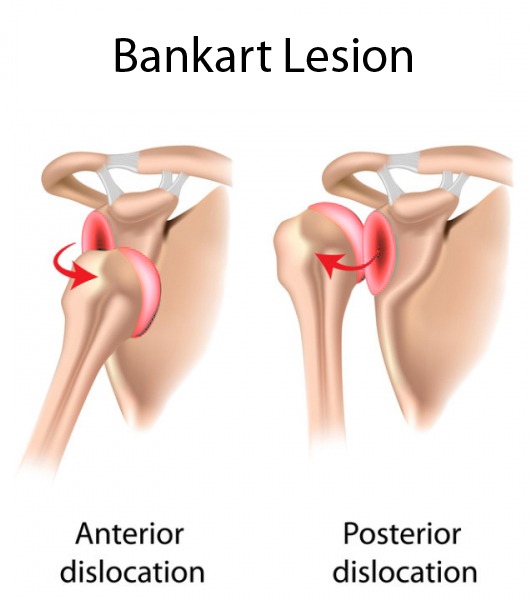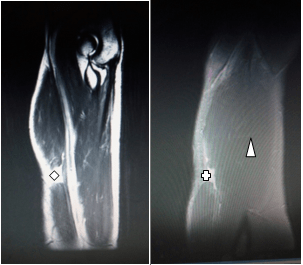Overuse injuries: People who engage in repetitive sports are the ones who are prone to overuse injuries. Overuse of the shoulder can cause loose ligaments and instability. Swimmers, tennis players, volleyball players, baseball pitchers, gymnasts, and weight lifters are prone to this kind of injury. Don’t think that non-athletes are immune to overuse injuries. People who engage in repetitive motion in work such as swinging a hammer are at risk of overuse injuries.
The bottom line is any sport or physical activity that can cause shoulder dislocation pose a risk for Bankart lesion.
Loose ligaments : Some people are prone to loose ligaments on account of genetic factors. Their shoulder can pop out of the shoulder socket easily.
Physical abuse: Violent physical actions, abuse, bullying can involve falls, blows or sudden wrenching movements that may pull the shoulder ball from the socket, thereby damaging the surrounding tissues.
Bankart Lesion – Symptoms
Ironically, symptoms of a Bankart lesion shares many symptoms with other shoulder injuries. A thorough physical examination is necessary to properly diagnose the underlying condition of the shoulder. Moderate to severe shoulder pain. Weakness and instability of the shoulder. Popping and clicking sensation when the shoulder is moved. Loss of range of motion of the shoulder. Repeated episodes of shoulder dislocation.
Typically, symptoms of a Bankart lesion may exhibit:
Pain: When trying to reach overhead during sleep or during day-to-day activities. Throwing a ball can trigger good amount of pain
Instability and weakness: The shoulder may just hang there. It may pop out of the shoulder socket and you may feel loose
Range of motion: Let alone range of motion, moving the shoulder itself may be difficult. Limited range of motion and moving the shoulder in any direction triggering pain is a clear-cut sign of Bankart lesion.
Unusual noise or sensations in the shoulder: Grinding or a catching sensation with shoulder subluxation or a popping sound can be all symptoms of a Bankart lesion.
Bankart Lesion – Diagnosis
Diagnosis begins with evaluation the past medical history of the patient. Physical examination provides a good clinical indication for a Bankart lesion. Your orthopaedic/shoulder doctor uses one or more of the following methods to diagnose a bankart injury:
o Physical Examination
o X-rays
o MRI
o Arthroscopy
o MR arthrography
o Radiographs (particularly for bony bankart lesions)
Bankart Lesion – Treatment Options
Depending on the severity and case of the Bankart Injury (traumatic injury, or chronic condition that arose without any apparent trigger), there are two types of treatment options – surgical and non-surgical. The first line of treatment is conservative and it involves temporary immobilization of the affected shoulder with a sling until the inflammation has subsided. If the bankart tear does not heal properly, it leads to further dislocations, instability and weakness of the shoulder.
Non-surgical treatment options
o Rest and immobilization (with or without a sling)
o Pain killers and Non-steroidal drugs (if the condition demands)
o Physical Therapy. With the help of a physiotherapist, you may be given an exercise program to stabilize the shoulder joint. Make sure you adhere to exercise program completely and doing the exercises the way it should be done is very importation for rapid healing.
It should be understood that with conservative treatment, there are chances of shoulder dislocating again.
Surgical Treatment:
If your shoulder continues to dislocate and feel unstable even after treating it with non-surgical methodologies, it may be time to think about surgery.
Arthroscopic Bankart Reconstruction (or simply Bankart Repair Surgery)
Surgery is often opted for younger patients and who play sports as there is an elevated risk of recurring dislocations. Surgery is often opted for patients whose condition does not improve using standard non-surgical methods of treatment. The purpose of surgical correction of Bankart Lesion is to reattach the torn labrum to the socket of the shoulder thus restoring stability to the shoulder. In most of the cases, surgery is performed arthroscopically (key hole surgery) however in some cases, standard open incision is required. Arthroscopic surgery also has the advantage of less pain and faster recovery compared to open surgical method. Surgery is successful in most of the cases allowing them to return to regular activities without the incidence of recurring dislocation. Complications after a bankart repair surgery are very rare. However as with any surgical procedure, this surgery may develop some risk like bleeding, infection, shoulder stiffness, injury to blood vessel or nerve.
Depending on the severity of the injury, other operative interventions to repair a Bankart lesion may include:
- Re-attaching the ligament
- Bone reshaping or grafting which will lend stability to the shoulder socket (glenoid)
- Thickening, building up or reshaping of the glenoid labrum cartilage
- Repair and ligament tightening to undo looseness and lend stability
Bankart Lesion – Rehabilitation
Post surgery, patient will be advised to wear a sling for first few weeks. Almost immediately, he has to undergo a physical therapy program. Depending on the severity of the condition, patient will be advised to keep away from certain activities for some period of time.
In patients with increased risk of shoulder dislocations due to strenuous sports activities, they are advised to wear proper safety equipment. Elderly patients are advised to avoid any possible falls.



